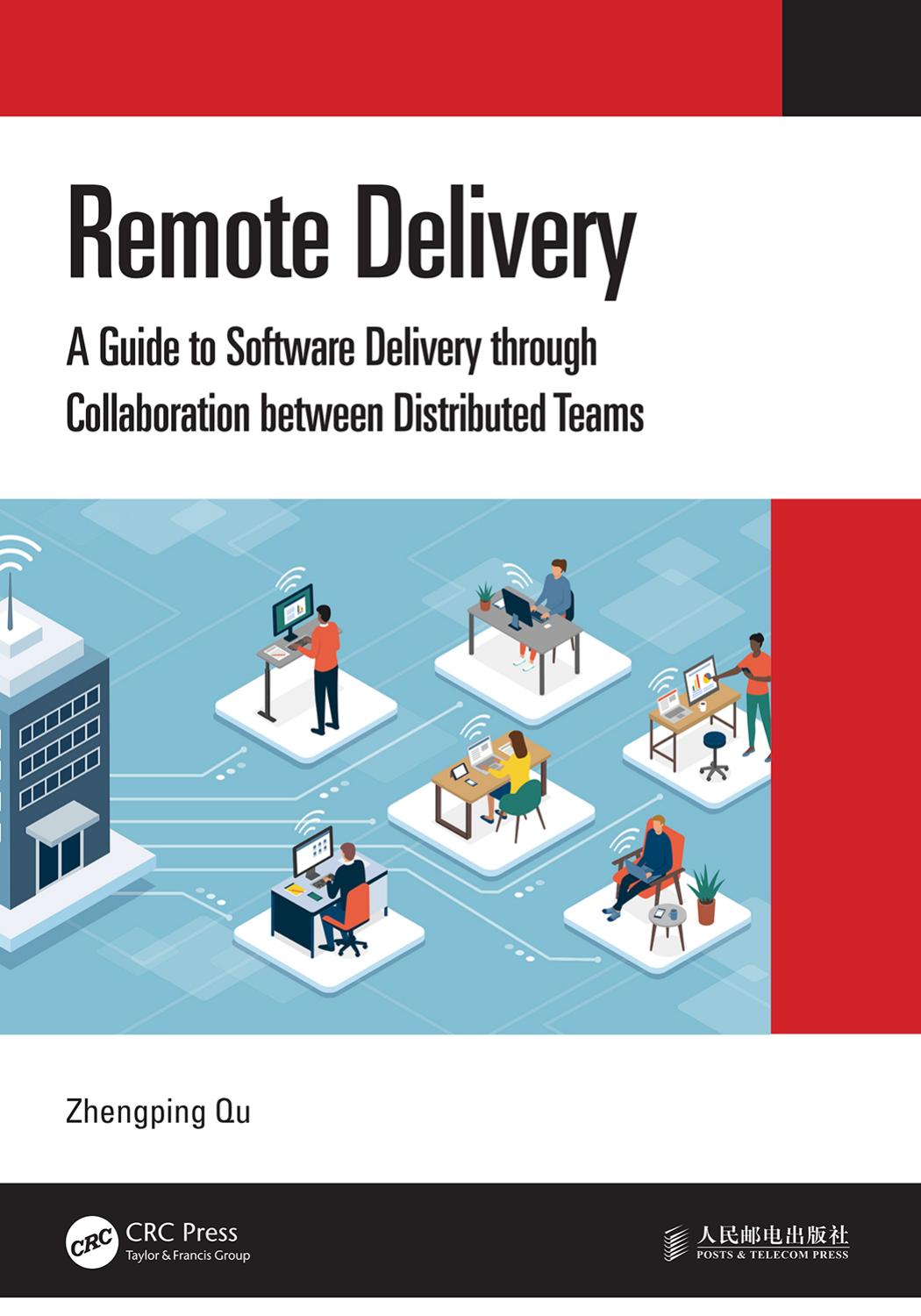Remote Delivery A Guide to Software Delivery through Collaboration between Distributed Teams 1st Edition by Zhengping ISBN 1000381528 9781000381528
$50.00 Original price was: $50.00.$25.00Current price is: $25.00.
Remote Delivery A Guide to Software Delivery through Collaboration between Distributed Teams 1st Edition by Zhengping Qu- Ebook PDF Instant Download/Delivery: 1000381528, 978-1000381528
Full download Remote Delivery A Guide to Software Delivery through Collaboration between Distributed Teams 1st Edition after payment

Product details:
ISBN 10: 1000381528
ISBN 13: 978- 1000381528
Author: Zhengping Qu
This book records the author’s years of experience in the software industry. In his own practices, the author has found that the distributed work pattern has become increasingly popular in more and more work environments, either between vendors and customers or between different teams inside a company. This means that all practitioners in the software industry need to adapt to this new way of communication and collaboration and get skilled enough to meet the greater challenges in integrating the distributed work pattern with agile software delivery.
By centering on the difficulties in communication and collaboration between distributed teams, this book digs into the reasons why so many remote delivery projects end up anticlimactic and provides solutions for readers’ reference. It also cites successful cases in promoting agile development in distributed teams, which has been a vexing problem for many software development companies. In addition, readers can find suggestions and measures for building self-managing teams in this book.
Remote Delivery: A Guide to Software Delivery through Collaboration between Distributed Teams is a very practical guide for software delivery teams with their members distributed in different places and companies engaged in software customization. Developers, QAs, product managers, and project leaders can also be inspired by this book.
Remote Delivery A Guide to Software Delivery through Collaboration between Distributed Teams 1st Table of contents:
Chapter 1: Current Situation of Distributed Teams
-
Introduction
- Rapid Development: Growth of distributed teams, driven by technological advancements.
- Importance of CMMI Assessment: Customers value this model for its standardized processes and improvement focus.
- Types of Distributed Teams: Vary based on roles, technology, and service scope.
- What is a Distributed Team? These teams work remotely, spread across different geographical locations.
-
Service Outsourcing Industry
- The outsourcing industry is shifting, with an increasing reliance on offshore teams for cost reduction and expertise.
-
Building an Offshore Team
- Principles: Effective communication, understanding culture, and clear objectives.
- Investment & Benefits: High investment but can yield substantial benefits, such as access to global talent.
- Challenges: Communication barriers, managing remote teams effectively.
-
Development Trends in Software Outsourcing
- Talent War: Competition for skilled professionals is intensifying.
- Offshore Centers: Strategic cooperation models with offshore delivery centers are growing.
- Customer Measurement: Shifting focus to new metrics for evaluating outsourcing success.
Chapter 2: Communication between Distributed Teams
-
Managing Customer Expectations
- Know the Customer: Understand their business and priorities to align expectations.
- Maintain Consistency: Ensure frequent and transparent communication to meet and exceed customer expectations.
-
Communication Challenges
- E-mail & Tools: E-mail remains crucial, but other tools (asynchronous and real-time) should be prioritized for efficiency.
- Conflict Resolution: Active communication and conflict management are key.
-
Meetings & Face-to-Face Interactions
- Regular team and client meetings (e.g., stand-ups, retrospectives) are essential for maintaining alignment.
- On-site representatives or short-term visits help enhance communication.
-
Online Communication Tools
- Tools for knowledge sharing, instant messaging, and project collaboration are indispensable for effective teamwork.
-
Failed Communication Cases
- Case studies (e.g., McDonnell-Douglas DC-10 crash, failed project integrations) show the severe consequences of communication breakdowns.
Chapter 3: Collaboration between Distributed Teams
-
Teamwork Essentials
- Collaboration & Communication: Close collaboration requires clear communication, shared goals, and mutual trust.
- Unified Opinions: Teams must agree on priorities, processes, and testing standards.
-
Improving Offshore Team Collaboration
- Emphasize two-way communication, regular check-ins, and visualizing progress to enhance collaboration.
-
Standardization
- Business, Technology & Testing: Standardizing these areas ensures smooth collaboration, reduces errors, and maintains quality.
Chapter 4: Application of Visualization
-
Purpose of Visualization
- Visual tools (like Kanban, Burndown charts) help track project status, improve understanding, and monitor quality.
-
Methods
- Use charts and mind maps for requirements visualization and tracking team progress.
-
Tools for Team Collaboration
- Tools like Mingle and Trello are introduced for effective team collaboration and project management.
Chapter 5: Waste in Distributed Teams
-
Human Factors
- Waste caused by human errors, lack of clear communication, and inefficiency is common in distributed teams.
-
Process Waste
- Minimizing process complexity and avoiding over-design helps reduce waste.
-
Information Processing
- Excessive information, poor management, and inefficient knowledge transfer cause significant waste.
-
Invisible Waste
- Invisible waste, like untracked progress or technical debt, must be identified and addressed to maintain team efficiency.
Chapter 6: Self-Managed Offshore Teams
-
Cultural Influences
- Team culture plays a significant role in driving performance. Self-management leads to higher autonomy and effectiveness.
-
Flat Organization & Team Professionalism
- Establishing a flat structure encourages initiative and self-management, fostering a high degree of professionalism.
-
Feedback & Transparency
- Teams must prioritize feedback and ensure information flows freely to facilitate continuous improvement.
Chapter 7: Customer-Oriented Offshore Teams
-
Building Trust with Customers
- Focus on transparency, communication, and delivering business value to build lasting customer relationships.
-
Managing Customer Expectations
- Handle disagreements, maintain open dialogue, and align team efforts with client goals for successful project delivery.
-
Managing Delivery Projects
- Fixed-Bid vs. Man-Day Projects: Understand the nature of contracts to manage expectations and delivery risks effectively.
Chapter 8: The Future of Distributed Teams
-
Personnel Management
- Adapt to changing team dynamics, ensuring smooth transitions during personnel changes while maintaining team culture.
-
Challenges & Technological Adaptation
- Distributed teams must stay adaptable, embracing new technologies while managing issues like time zone differences and domain knowledge.
-
Future Trends
- Offshore teams will continue to be a key factor in digital innovation, especially in traditional industries embracing agile models.
People also search for Remote Delivery A Guide to Software Delivery through Collaboration between Distributed Teams 1st:
what is remote delivery in pregnancy
signs of remote delivery in living
roku remote delivery
woolworths remote delivery
difference between recent and remote delivery
Tags:
Zhengping,Remote,Delivery,Guide,Software,Delivery,Collaboration,Distributed Teams 1st
You may also like…
Biology and other natural sciences - Plants: Agriculture and Forestry
Business & Economics
Medicine
A Practical Manual to Labor and Delivery 2nd edition by Shad Deering 9781108407830 1108407838
Business & Economics
Computers - Programming
Uncategorized
The Async First Playbook Remote Collaboration Techniques for Agile Software Teams 1st Edition Moghe












